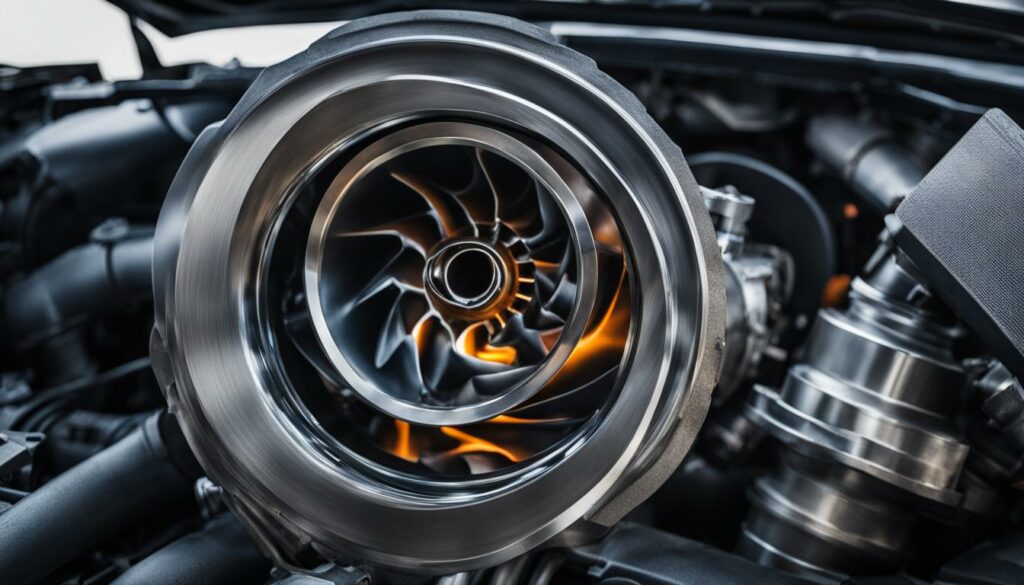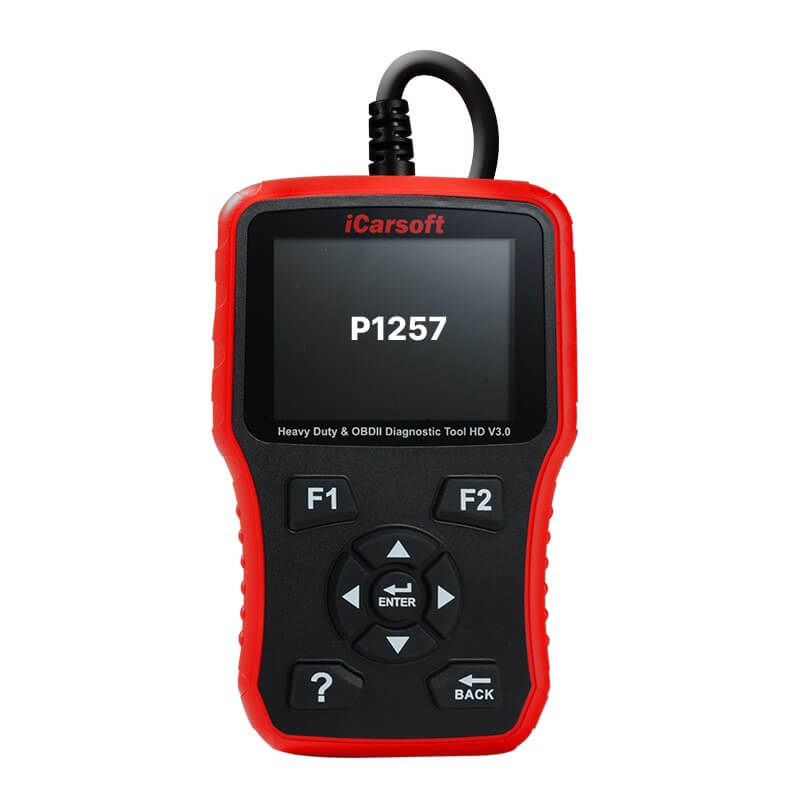P1257 – Turbo Boost Pressure Not Detected – Mechanical Failure
POSTED IN pcodes
Welcome to our article on P1257 – Turbo Boost Pressure Not Detected – Mechanical Failure. In this article, we will explore this diagnostic trouble code and its implications, as well as provide information on the symptoms, diagnosis, and troubleshooting steps. Turbocharger malfunction and boost pressure loss can significantly impact your engine’s performance, so it’s essential to address this issue promptly. Let’s dive in and learn more about P1257!
Key Takeaways:
- P1257 is a diagnostic trouble code that indicates a mechanical failure in the turbocharger system.
- It can lead to a loss of turbo boost pressure and reduced engine performance.
- Common symptoms of P1257 include a decrease in engine power, reduced acceleration, and increased exhaust emissions.
- Diagnosis involves visual inspection, scan tool retrieval of diagnostic trouble codes, and analyzing live data from the engine control unit.
- Addressing the issue may require replacing damaged components or the entire turbocharger unit.
Understanding P1257 and its Severity
The P1257 code is an important diagnostic trouble code that indicates a mechanical failure in the turbocharger system. Specifically, it signifies a lack of detected boost pressure, which can have severe consequences for the performance and functionality of the engine. Ignoring this issue can lead to further damage to the turbocharger and other critical engine components. Therefore, it is crucial to understand the severity of this code and take appropriate action.
When the turbocharger system fails to generate adequate boost pressure, it results in a significant loss of power and reduced engine performance. This can be noticed through sluggish acceleration and decreased overall efficiency. The turbocharging system directly affects the engine’s ability to generate sufficient power, and any malfunction can severely impact its performance.
Furthermore, a malfunction in the turbo boost system can lead to higher exhaust emissions and compromised fuel efficiency. This not only has negative environmental implications but also affects the overall running costs of the vehicle.
To ensure the optimal operation of the engine and prevent further damage, it is essential to address the turbocharger issues associated with the P1257 code promptly. The severity of this code warrants immediate attention and thorough diagnosis to identify the root cause of the mechanical failure.
Buy tested tuning file for Adblue / EGR / DPF / Adblue off now!

By promptly diagnosing and addressing the issues associated with the P1257 code, you can avoid costly repairs and restore your vehicle’s performance to its optimal level. In the following sections, we will explore the symptoms, diagnosis, and troubleshooting steps to effectively resolve turbocharger issues and ensure the longevity of your engine.
Symptoms of P1257
When a vehicle displays a P1257 code, it is essential to understand the symptoms associated with this issue. By recognizing these symptoms, you can determine if your vehicle is experiencing a mechanical failure within the turbocharger system. Common symptoms of a P1257 code include:
- Decrease in engine power: You may notice that your vehicle lacks the power it once had, resulting in reduced overall performance.
- Reduced acceleration: If your vehicle is slow to respond or struggles to accelerate, it could be a sign of a turbocharger problem.
- Loss of turbo boost: A malfunctioning turbocharger can lead to a noticeable decrease in turbo boost, affecting your vehicle’s speed and power.
In addition to these symptoms, you might also experience a decrease in fuel efficiency and an increase in exhaust emissions. These indicators can further confirm the presence of a P1257 code.
The most common cause of a P1257 code is a mechanical failure within the turbocharger system. This failure is typically attributed to a faulty wastegate or boost control system. To troubleshoot the issue, it is crucial to thoroughly inspect these components for any signs of damage or malfunction.
Inspection Tip: When inspecting the turbocharger system, pay close attention to the wastegate and boost control system. Look for any visible signs of wear, such as damaged or disconnected hoses, loose connections, or malfunctioning sensors.
By understanding the symptoms and potential causes of a P1257 code, you can take the necessary steps to diagnose and address the issue promptly, ensuring optimal performance and preventing further damage to your vehicle’s turbocharger system.

Common Symptoms of P1257:
- Decrease in engine power
- Reduced acceleration
- Loss of turbo boost
Diagnosis and Troubleshooting Steps
When encountering a P1257 code, it is essential to follow a systematic approach to diagnose and troubleshoot the issue. By performing a careful inspection and utilizing diagnostic tools, you can identify the cause of the problem and take appropriate repair measures.
1. Visual Inspection
A visual inspection of the turbocharger system is the first step in diagnosing a P1257 code. Inspect all components, including the turbocharger, intercooler, hoses, and connections, for any visible damage or leaks. Look for signs of oil leakage, loose or damaged clamps, worn-out seals, or detached hoses. This inspection is crucial in identifying any physical issues that may be contributing to the code.
2. Scan Tool Analysis
Using a scan tool, retrieve any additional diagnostic trouble codes (DTCs) stored in the engine control unit (ECU). This step is important as it can provide valuable insights into related issues that may be impacting the turbocharger system. Additionally, view live data from the ECU to monitor the turbocharger’s operation and gather information on boost pressure, throttle position, and other relevant parameters. Analyzing this data can help in pinpointing the source of the problem.
3. Addressing Potential Causes
Based on the visual inspection and scan tool analysis, there are several potential causes for the P1257 code. Some common causes include a malfunctioning wastegate, a faulty boost control solenoid, or a clogged or restricted intake or exhaust system. It is important to address these potential causes systematically, starting with the most likely culprits.
4. Repair Procedures
Once the cause of the P1257 code has been determined, appropriate repair procedures can be implemented to resolve the issue. Depending on the specific problem, repairs may involve replacing damaged components, cleaning or unclogging intake or exhaust paths, or repairing or adjusting the wastegate or boost control system. It is crucial to follow the manufacturer’s recommended repair procedures and use genuine or high-quality replacement parts to ensure a proper repair.
Remember, if you are not familiar with automotive repairs or lack the necessary tools, it is advisable to seek professional assistance from a qualified mechanic or technician. They have the expertise and experience to accurately diagnose the P1257 code and perform the necessary repairs to restore the turbocharger system’s functionality.
| Steps | Actions |
|---|---|
| 1 | Perform a visual inspection of the turbocharger system |
| 2 | Use a scan tool to retrieve additional DTCs and view live data from the ECU |
| 3 | Address potential causes, such as a malfunctioning wastegate or clogged intake/exhaust system |
| 4 | Implement appropriate repair procedures based on the identified cause |
Addressing the Turbo Boost Pressure Loss
If a turbocharger malfunction is identified as the cause of the boost pressure not detected, it is important to address the issue promptly to prevent further damage. The turbocharger plays a crucial role in enhancing engine performance, and any malfunction can negatively impact the overall functioning of the vehicle.
Depending on the severity of the damage, there are several turbocharger troubleshooting options to consider for resolving the boost pressure loss:
- Inspecting the Wastegate: The wastegate is responsible for regulating the boost pressure in the turbocharger system. If it is found to be faulty or damaged, replacing the wastegate might be necessary to restore proper boost pressure.
- Checking the Boost Control Solenoid: The boost control solenoid controls the flow of air to the turbocharger. Malfunctioning solenoids can result in boost pressure loss. Inspecting and replacing the boost control solenoid, if necessary, can help rectify the issue.
- Replacing the Turbocharger Unit: In some cases, when the damage to the turbocharger is significant, replacing the entire turbocharger unit might be required. This option ensures optimum performance and reliability.
It is crucial to consult with a professional mechanic or technician to accurately diagnose the underlying cause of the turbo boost pressure loss. They have the expertise and resources to determine the best course of action based on the specific circumstances of your vehicle. Promptly addressing the turbo boost pressure loss can help maintain optimal engine performance and prevent further complications down the road.
Turbo Boost Pressure Loss Troubleshooting Table
| Possible Causes | Troubleshooting Steps |
|---|---|
| Wastegate failure | 1. Inspect wastegate for damage or malfunction.
2. Replace the wastegate if necessary. |
| Boost control solenoid malfunction | 1. Check the boost control solenoid for any signs of malfunction.
2. Replace the boost control solenoid if needed. |
| Turbocharger damage | 1. Assess the extent of turbocharger damage.
2. Consider replacing the entire turbocharger unit for optimal performance. |
Conclusion
In conclusion, the P1257 code indicates a mechanical failure in the turbocharger system, resulting in a loss of detected boost pressure. This issue can significantly impact the performance of your engine, leading to a decrease in power and acceleration. It is crucial to address turbocharger issues promptly to prevent further damage and maintain optimal engine performance.
When facing a P1257 code or other turbocharger problems, it is recommended to seek professional assistance from a skilled mechanic or technician. They have the expertise and diagnostic tools to accurately identify the cause of the issue and perform effective repairs. Remember, attempting repairs without the necessary knowledge and experience can often result in more costly damage.
If professional assistance is unavailable, there may be alternate solutions. However, it is important to exercise caution and consider specialized online platforms that offer advanced ECU programming services. These platforms can provide the option to upload the Engine Control Unit (ECU) file and potentially remove the P1257 code permanently. However, it is essential to thoroughly research and ensure the reliability and legitimacy of these services.
FAQ
What does the P1257 code mean?
The P1257 code indicates that the turbo boost pressure is not being detected due to a mechanical failure in the turbocharger system.
What are the symptoms of a P1257 code?
Some common symptoms of a P1257 code include a decrease in engine power, reduced acceleration, a loss of turbo boost, decreased fuel efficiency, and increased exhaust emissions.
What are the common causes of a P1257 code?
The most common cause of a P1257 code is a mechanical failure within the turbocharger system, often due to a faulty wastegate or boost control system.
How can I diagnose and troubleshoot a P1257 code?
To diagnose a P1257 code, it is recommended to perform a visual inspection of the turbocharger system and use a scan tool to retrieve any additional diagnostic trouble codes and view live data from the engine control unit (ECU). This data can help identify the source of the issue, such as a damaged wastegate or boost control solenoid.
How can I address the turbo boost pressure loss caused by a P1257 code?
If a mechanical failure is identified as the cause of the boost pressure loss, appropriate repair procedures will depend on the severity of the damage. This may involve replacing damaged components, such as the wastegate or boost control solenoid, or potentially replacing the entire turbocharger unit.


